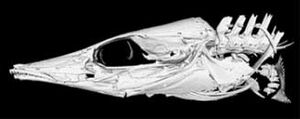Mastacembelus platysoma facts for kids
Quick facts for kids Mastacembelus platysoma |
|
|---|---|
 |
|
| CT scan of head of Mastacembelus platysoma |
|
| Conservation status | |
| Scientific classification | |
| Synonyms | |
|
Mastacembelus platysoma is a type of fish known as a spiny eel. It belongs to the family Mastacembelidae. You can find this fish only in Lake Tanganyika. This large lake is shared by four countries: Burundi, the Democratic Republic of the Congo, Tanzania, and Zambia.
The IUCN (International Union for Conservation of Nature) has listed Mastacembelus platysoma as a species of "Least Concern". This means it is not currently at risk of disappearing.
About the Spiny Eel
Mastacembelus platysoma has a long, thin body, much like an eel. It also has a long snout. At the end of its snout are two special tube-shaped nostrils.
Along its back, this fish has a row of spines that are spaced far apart. Its body has 71 vertebrae, which are the bones that make up its backbone. This spiny eel can grow up to about 16 centimeters (about 6 inches) long.
Where It Lives
Mastacembelus platysoma is an endemic species. This means it lives only in one place in the world: Lake Tanganyika. You won't find it naturally anywhere else!
It prefers to live in the rocky areas along the coast of the lake. These fish usually stay at depths of up to about 30 meters (about 98 feet).
Life in the Lake
Mastacembelus platysoma is one of 14 different kinds of spiny eels that live in Lake Tanganyika. All these spiny eels came from a single ancestor fish a long time ago. Over time, they changed and developed special features. This process is called adaptive radiation.
Each type of spiny eel has adapted to fit a different "job" or way of life in the lake. This helps them avoid competing with each other for food and space. For example, some might eat different foods, or live in slightly different parts of the lake.
Conservation Status
The IUCN has given Mastacembelus platysoma the status of "Least Concern". This is good news for the fish. It means there are many of them across a wide area of Lake Tanganyika. Scientists have not found any major threats that could harm this species.


